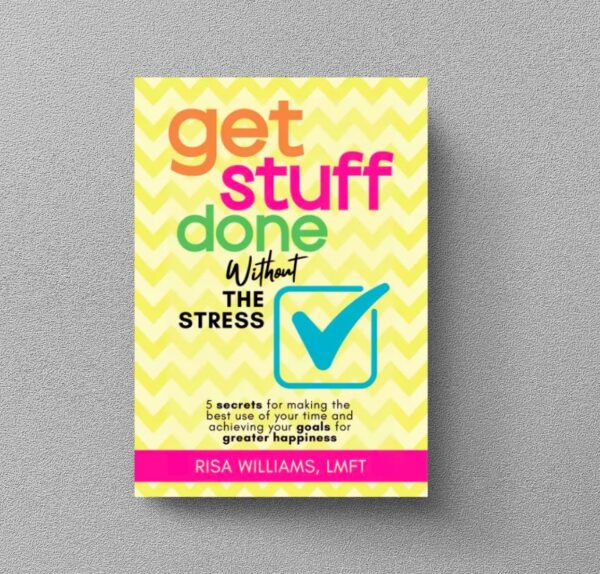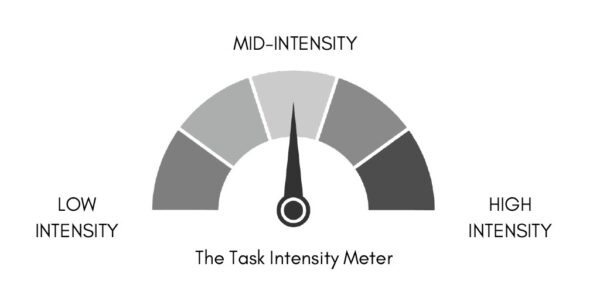If you’re a procrastinator like me… you’ve probably tried everything to help you push through it.
There’s no shortage of gimmicks and “productivity hacks” out there promising to transform your approach to getting things done: getting up at 4am, ice cold showers, trying to motivate yourself with shame… (Hey, no shade if any of these work for you! They just didn’t help me 😅).
The thing that transformed my ability to get work done sounds simple — but it’s not necessarily quick or easy: it’s a mindset shift.
What was my shift? Well, a few years ago after diving into neuroscience and psychology research, I came to the understanding that procrastination is not really about laziness… it’s actually rooted in fear, anxiety, and uncertainty. It happens because our brain is actually trying to protect us from the negative emotions we associate with our tasks, so it won’t let us start them!
This set me off on a whole different path to find new approaches to productivity that are rooted in self-compassion, not self-criticism. I even co-founded a company, Focused Space, to help people put a lot of these methods into practice every day.
Part of my job is always reading about new time management techniques to bring to our members — we love this stuff! — and one of the books that inspired me the most this year is called Get Stuff Done Without the Stress, by psychotherapist and time management expert Risa Williams.
It’s a practical, accessible, and compassionate approach to getting things done that won’t waste your time. Risa has written many books that I am a fan of, and this latest book is based on her own personal experiences getting lost in overwhelm, frustration, and stress while working towards her goals — and how she learned how to break herself out of the burnout cycle.
I’m thrilled to bring you a few of my favorite takeaways from the book, and hope you get a chance to check it out for yourself because there are a TON of great tools I don’t have space for in this article.
Here are three takeaways from the book that resonated with me the most:
We Are Humans, Not Robots
What’s the difference between healthy productivity and toxic productivity? It can be hard to spot sometimes! Risa’s book explains how to tell when you might be slipping into a “toxic productivity” mindset that makes you feel more like a robot than a human being… which we are all susceptible to. Williams asks readers to question this unhealthy tendency, and choose to adopt a “self-kindness” approach instead, one that prioritizes rest, resetting, and daily self-care as essential to our wellbeing.
The main takeaway: downtime is not “lazy.” It’s a necessity because it helps our brains and bodies function, it helps us be creative and not robotic, and helps us stay motivated over the long-term. Her book offers tips for connecting with our humanity as we work towards our goals.
Task Intensity Meter
One of my favorite visual tools from the book is called the Task Intensity Meter. You can visualize it like this…
When Risa says “intensity,” what she means is this: how stressful and intense does this particular task feel for you to do?
You would ask yourself: does the task I am doing feel high, middle, or low intensity to me right now? One everyday example Williams gives in her book: Doing the laundry.
How would you rate laundry right now for you as a task — would it be low, middle, or high-level intensity?
If you feel like laundry is a high-intensity task, you’re not the only one! Everyday tasks can stress people out far more than you might think, and we all have different tasks that stress us out. If laundry is easy for you, I bet you can think of a different household chore that isn’t so stress-free for you…
Just by becoming more aware of which tasks tend to feel high intensity to you, you can start to find ways to make things easier on yourself each week — such as trying not to schedule more than two high-intensity tasks for the same day.
The Hats Method
This book has too many gems to fit into one article (Link: https://www.amazon.com/Get-Stuff-Done-Without-Stress/dp/1684816874) — but I have space to share one final tool I loved: “The Hats Method.”
This method helps me focus my attention on what needs to be done so I can avoid “decision fatigue,” or the exhaustion that comes with trying to make too many choices in one day.
Here’s how it works:
Imagine you have a free hour in front of you. But before you do anything, you have to select an imaginary “hat” to wear first.
This represents the mental gear you must shift into as you open up this “time box” and work on the tasks inside.
The “Hats Method” is an easy visualization to help you learn how to narrow your focus down to what’s directly in front of you. You can ask yourself: “Which ‘hat’ do I need to wear for the next upcoming segment of time?”
We know that sometimes you have to wear more than one hat at a time, but being intentional about which hats you are wearing at a given time can help you avoid multitasking, stay present in the moment, transition between things in a calmer way, and know what energy is required of yourself.
These are just a few of the many takeaways from my favorite productivity book this year, Get Stuff Done Without the Stress. There are so many other easy exercises in the book that can really move the needle for you if you tend to struggle with procrastination. Unlike other productivity books I’ve read that feel overly philosophical or unrealistic, this one is extremely practical, full of quick and easy strategies that I could actually incorporate into my life right away.
It’s helped me shift my mindset, and also gave me a bunch of simple tools I could use to get more done — without stressing myself out unnecessarily.
*
Get Stuff Done Without the Stress by Risa Williams is available at getstuffdonebook.com or at risawilliams.com.



